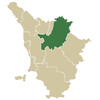|
 Sesto
Fiorentino, lies on the old Roman road that runs west from Firenze
and passes through Terzolle, Quarto, Sesto, and Settimello. Sesto Fiorentino
is situated on the plain at the foot of Monte Morello, and has
kept the name of the Roman settlement that grew up six miles from Firenze.
Following land reclamation work carried out by the Medici in the plain
area, Sesto became an important agricultural centre, and in 1735 the first
industrial development started when Marchese Ginori established the prestigious
Manifattura delle Porcellane di Doccia there. The Museo delle
Porcellane di Doccia documents the history of the porcelain factory. Sesto
Fiorentino, lies on the old Roman road that runs west from Firenze
and passes through Terzolle, Quarto, Sesto, and Settimello. Sesto Fiorentino
is situated on the plain at the foot of Monte Morello, and has
kept the name of the Roman settlement that grew up six miles from Firenze.
Following land reclamation work carried out by the Medici in the plain
area, Sesto became an important agricultural centre, and in 1735 the first
industrial development started when Marchese Ginori established the prestigious
Manifattura delle Porcellane di Doccia there. The Museo delle
Porcellane di Doccia documents the history of the porcelain factory.
In the Castello area are the grand Medici villas, which
subsequently became royal villas. Villa Petraia was built on top
of a castle belonging to the Brunelleschi family, and like the well-known
Villa Reale di Castello it looks out over a splendid Italian-style
garden.
Settimello gets its name from the fact that it developed at the
seventh milestone of the Via Cassia running towards Pistoia. It
continued to grow in the medieval period because the Via Francigena also
passed by here, and pilgrims used to stop off at the Castello di Calenzano,
which was subsequently destroyed by Castruccio Castracani in 1325.
A wonderful view can be had from Monte Senario, site of the monastery
of the Servite Order. And from there it's not far to Fiesole, which
was founded by the Etruscans in the 3rd century BC. Besides the
other historical remains, a visit to the Roman theatre is an absolute
must. In the area around Fiesole there is also Maiano, which is
well-known for its pietra serena quarries on Monte Ceceri.
Just a few kilometres north from Fiesole, amidst rolling hills, lies
the Mugello and the Valdiseve areas.
Bagno a Ripoli, south east of Firenze, is Etruscan in origin,
and the Romans built thermal baths there, blocking off part of
the river Arno at Ripule, hence the name. Upper-bourgeois Florentines
have built sumptuous houses in the green hills here, and there are many
historical religious buildings such as the Pieve di S. Maria dell'Antella
and the Pieve di S. Donnino a Villamagna, the Oratorio di Santa Caterina
a Rimezzano and the church of Mondeggi.
Built on a hill to the south of Firenze, on the edge of the Chianti
area, there is the splendid complex of the Certosa del Galluzzo,
which was founded in 1342 by Niccolò Acciaioli and contains many
art works.
After crossing the woody hills of Roveta, where there is the Pieve
di S. Alessandro a Giogoli, you arrive in Lastra a Signa; here
the town centre is still surrounded by the walls that Brunelleschi built
in 1365 on the orders of the Florentine Republic. Also of interest is
the Ospedale di Sant'Antonio, founded in 1411, which has an external loggia,
also by Brunelleschi. Nowadays there is a highway exit at Lastra a Signa
and there has been considerable industrial development.
In the plain area towards Scandicci there is the monastic complex
of Badia a Settimo.
Finally, there is Campi Bisenzio, which developed as a result of
the agrarian division of the Florentine plain, and is now an industrial
centre. In the medieval period, the Castello di Campi was so strong
that it became the capital of the league uniting the people living in
Calenzano, Signa, and Montemurlo.
Going more south we have the once-walled village of Montaione, near
the village there is the convent of San Vivaldo, which has a series of
16th century chapels decorated with works of art, including terracotta
groups by the Della Robbia school.
Certaldo is another small town whose territory is crossed by the
Via Francigena, and despite the modern industrial development its historic
centre of tower-houses, palaces and battlemented walls is still intact.
Its biggest claim to fame is that it was the birthplace of Giovanni Boccaccio,
who is also thought to have spent the last years of his life here.
Picture by Sandro Santioli
|